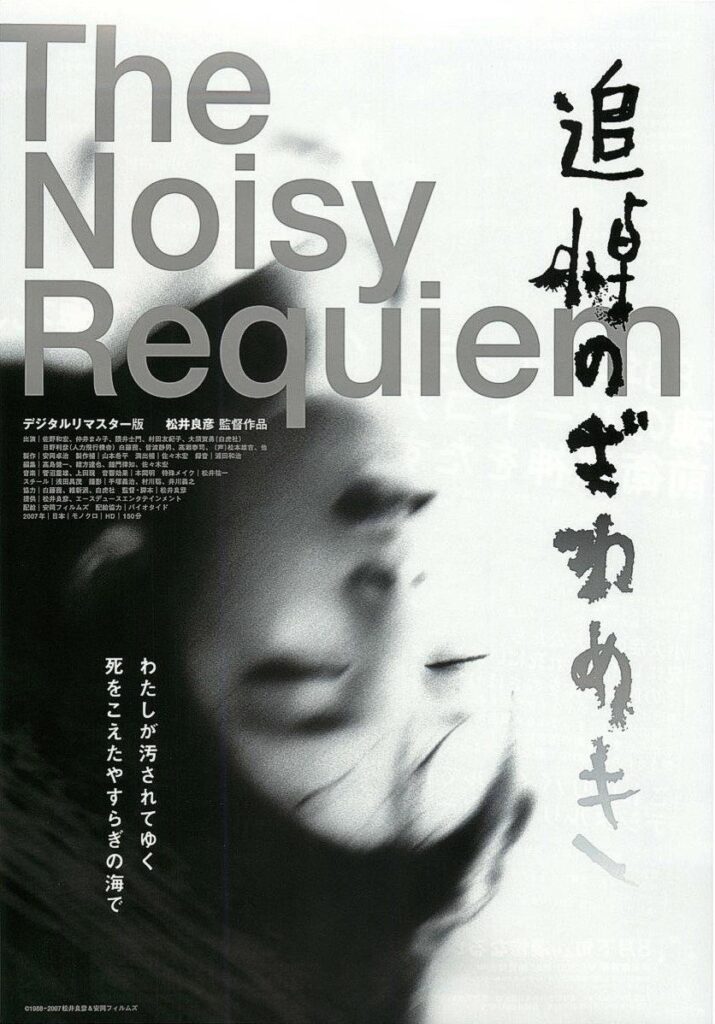
Noisy Requiem (1988), directed by Yoshihiko Matsui, is a provocative and unflinching exploration of society’s marginalized individuals. Set in the slums of Osaka, the film delves into the lives of outcasts, presenting a stark portrayal of their struggles and desires.
Production Background
Matsui dedicated five years to crafting Noisy Requiem, a testament to his commitment to depicting the raw realities of those living on society’s fringes. The film’s black-and-white cinematography enhances its gritty atmosphere, immersing viewers in the bleak world of its characters. Collaborating with figures from Japan’s underground cinema scene, including Sogo Ishii and Shinya Tsukamoto, Matsui’s work stands as a significant contribution to the genre .
Plot Overview
The narrative follows Makoto, a deranged individual who commits heinous acts, including murder and mutilation, driven by his obsession with a mannequin he considers his lover. Alongside Makoto’s story, the film presents other characters: incestuous siblings, a dwarf couple facing societal rejection, and a mentally challenged street performer. Each character’s tale underscores themes of alienation, longing, and the human need for connection .
Cast and Performances
Kazuhiro Sano as Makoto
Yukiko Murata as the younger sister
Simon Kumai as the older brother
Mamiko Nakai as Natsuko
Toshihiko Hino as Natsuko’s brother
The ensemble cast delivers compelling performances, bringing depth to characters that might otherwise be dismissed as mere grotesques. Their portrayals invite empathy, challenging viewers to see beyond the characters’ disturbing actions .
Cinematography and Direction
The film’s stark black-and-white visuals, captured by cinematographers Yoshiyuki Igawa, Satoshi Murakawa, and Yoshiharu Teduka, contribute to its oppressive atmosphere. Matsui’s direction is unflinching, presenting scenes of violence and depravity without sensationalism, forcing viewers to confront the harsh realities faced by the marginalized .
Critical Reception
Noisy Requiem has garnered a mixed reception. On Filmaffinity, it holds a rating of 5.9/10 based on 32 votes . However, on MUBI, it boasts a higher rating of 7.9/10 from 159 users . Critics have praised its uncompromising vision and its poignant commentary on societal neglect, though its graphic content and nonlinear narrative have limited its mainstream appeal .
Conclusion
Noisy Requiem is a harrowing yet essential piece of cinema that confronts viewers with the often-ignored plights of society’s outcasts. Through its unrelenting portrayal of marginalized lives, the film challenges audiences to reflect on the structures that lead to such profound alienation. While not for the faint-hearted, Matsui’s work remains a poignant exploration of humanity’s darker facets.
Addition
Yoshihiko Matsui’s Noisy Requiem (1988) is a visceral plunge into the underbelly of Osaka, portraying the lives of society’s most marginalized individuals. The film’s stark black-and-white cinematography and unflinching narrative confront viewers with themes of alienation, obsession, and the human yearning for connection.
Set in the slums of Osaka, the film follows Makoto, a deranged individual who commits heinous acts, including murder and mutilation, driven by his obsession with a mannequin he considers his lover. Alongside Makoto’s story, the film presents other characters: incestuous siblings, a dwarf couple facing societal rejection, and a mentally challenged street performer. Each character’s tale underscores themes of alienation, longing, and the human need for connection.
The ensemble cast delivers compelling performances, bringing depth to characters that might otherwise be dismissed as mere grotesques. Their portrayals invite empathy, challenging viewers to see beyond the characters’ disturbing actions.
The film’s stark black-and-white visuals contribute to its oppressive atmosphere. Matsui’s direction is unflinching, presenting scenes of violence and depravity without sensationalism, forcing viewers to confront the harsh realities faced by the marginalized.
Noisy Requiem has garnered a mixed reception. On Filmaffinity, it holds a rating of 5.9/10 based on 32 votes. However, on MUBI, it boasts a higher rating of 7.9/10 from 159 users. Critics have praised its uncompromising vision and its poignant commentary on societal neglect, though its graphic content and nonlinear narrative have limited its mainstream appeal.
Noisy Requiem is a harrowing yet essential piece of cinema that confronts viewers with the often-ignored plights of society’s outcasts. Through its unrelenting portrayal of marginalized lives, the film challenges audiences to reflect on the structures that lead to such profound alienation. While not for the faint-hearted, Matsui’s work remains a poignant exploration of humanity’s darker facets.
